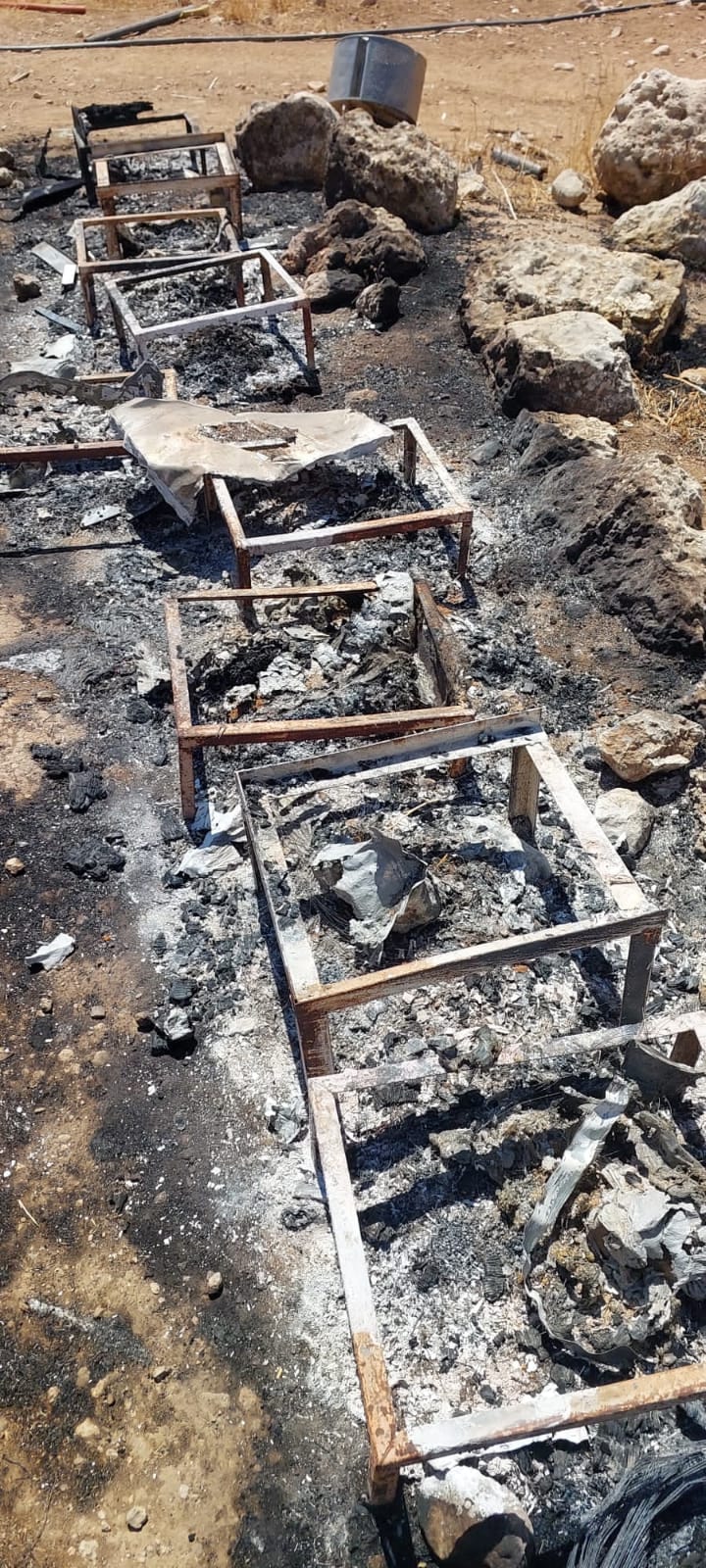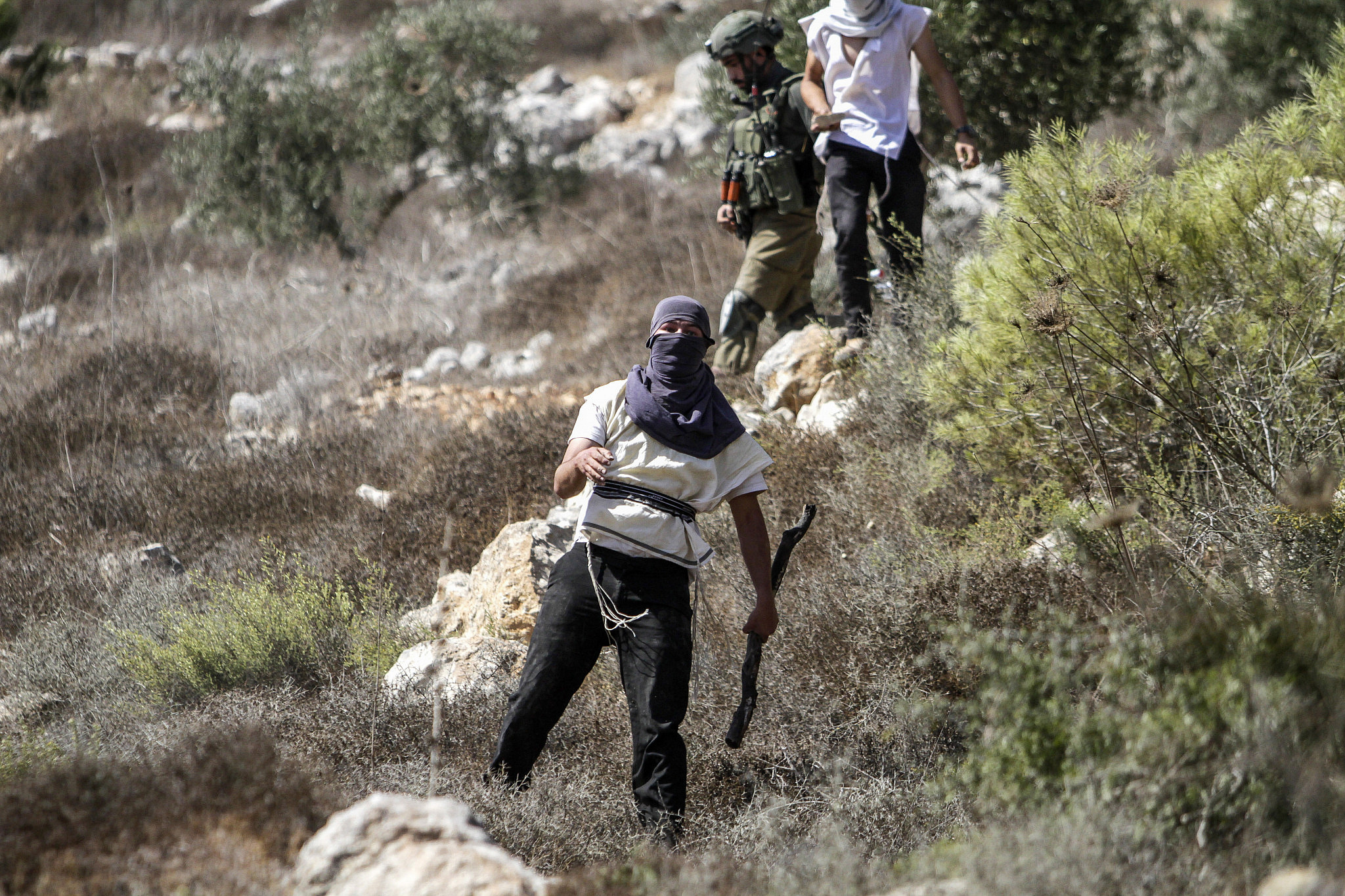– by Imad Abu Hawash – 30/8/2023
The Green Olive Collective recently joined an annual visit to the village of Umm Al Khair in the South Hebron Hills during the honey harvest. The village built a honey bee farm in 2018. Last year residents of the adjoining settlement Carmel complained to the army that the bees were flying over the fence into the settlement and sprayed pesticides killing the bees in several of the boxes. This forced the villagers to move their honey bees to the village of Dura, where they thought they would be safe. This article by Imad Abu Hawash was originally published in +972 and discusses the reality in Area C of the occupied West Bank, where even the bees and the air are policed within a strict system of segregation and subject to settler violence.
Youssef Ahmed Abdel Hamid Al-Sarha has been working in beekeeping and hive production for more than 15 years. Throughout that time, the 42-year-old from the West Bank village of Dura, near Hebron, has been putting his bee boxes in pastoral areas in the South Hebron Hills region. Here, medicinal herbs, green trees, and other natural resources provide a suitable environment for his work.
Seven years ago, he and his family placed some of these boxes — about 55 cells — in the small rural village of Khirbet Wedadie, and asked a friend who lived in the area, Saleh Abu Awad, to take care of the bees during his absences. But in 2021, Israeli settlers established an outpost called Meitarim Farm about 400 meters away from where the bees were located.
About a month ago, according to Al-Sarha and Abu Awad, the settlers started to seize land and plant grapes in the eastern region, less than a kilometer away from his bee boxes. They then began launching repeated attacks on Abu Awad and his family, who last month were forced to leave their land in Wedadie, which the family had inhabited for at least 200 years, due to the increasing violence. Abu Awad’s family, along with his brother’s family, tore down their homes with their own hands and left.
On July 27, Al-Sarha went back to the area to leave some water for the bees. “A settler came driving a four-wheel-drive mountain vehicle, carrying a weapon, with a huge dog that started wandering around me,” he recounted. “He was trying to scare me with the dog, and then he left.” Al-Sarha added that, on a previous visit, he noticed a small drone — perhaps belonging to the settler — tracking him from above until he left the area.

He went back a few days later, on August 1, to collect the honey — but instead he found ashes. “Twenty beehives had been burned out of 55,” he said, inflicting a financial loss of almost NIS 40,000 (around $10,500). Now vulnerable to the same settler violence that had chased away his friend’s family, Al-Sarha was forced to move the surviving hives to another area.
“My wife, my children, and I work hard most of our days for this moment; we wait for the annual season in which we can harvest honey and sell it,” he explained. “But this year, 20 boxes of bees became ashes, a week after the farmer’s family was forced to demolish his home and leave because of the settlers’ attacks.”
‘Has the land shrunk around us?’
For weeks up until they fled, the settlers were attacking the homes and fields of Abu Awad and his brother, day and night, often setting fires on parts of the land. But the Israeli authorities would never act on Abu Awad’s or Al-Sarha’s complaints, despite the evidence of settler attacks. The latter stood bewildered in front of the burning hives, wondering if the settler might even take revenge if he found out that Al-Sarha spoke to the police.
In the aftermath of the attack, fear hovered under the shadow of the outpost. Al-Sarha explained that he had started searching for land he owns in the Jordan Valley, some miles north of Wedadie. He will take his family and what remains of the beehives to re-establish his home there. In the southern West Bank, he added, the settlers are notorious for their violence, and they receive full protection from the state and its security forces, which are now headed by a man who lives in the Hebron-area settlement of Kiryat Arba, Itamar Ben Gvir.

“Has the land shrunk around us?” Al-Sarha asks angrily. “Where shall we go?” He wonders if beekeepers in Israel would ever be exposed to such violence.
Of course they wouldn’t. Al-Sarha’s beehives, like Abu Awad’s home, are the targets of an Israeli plan to eliminate any attempts by Palestinians to remain on their land in Area C, which makes up nearly two-thirds of the occupied West Bank. The large number of Israeli military orders issued in the South Hebron Hills in recent years — including for evictions, demolitions, and other restrictions — have become obstacles to any Palestinian progress in these areas. All the while, the power of the settlers increases under the ever-deepening legal apparatus that protects their interests.
Around the village of Khirbet Soba just west of Hebron, for example, Israeli bulldozers uprooted hundreds of olive and grape trees in early August to make way for settlement expansion, destroying dunams of agricultural land, and clearing the inhabitants through eviction orders. In the settlement of Ma’on, meanwhile, in the South Hebron Hills, the settlers have cut down trees to build homes for themselves, and the Palestinians who own and cultivate the land are prevented from even setting up a tent in the area.
On all sides of the Hebron region, nothing Palestinian — from humans to trees to bees — can escape the Israeli occupation.
Imad Abu Hawash is a Palestinian activist and researcher from Al-Tabaqa near Dura, southwest of Hebron.

Comment (0)